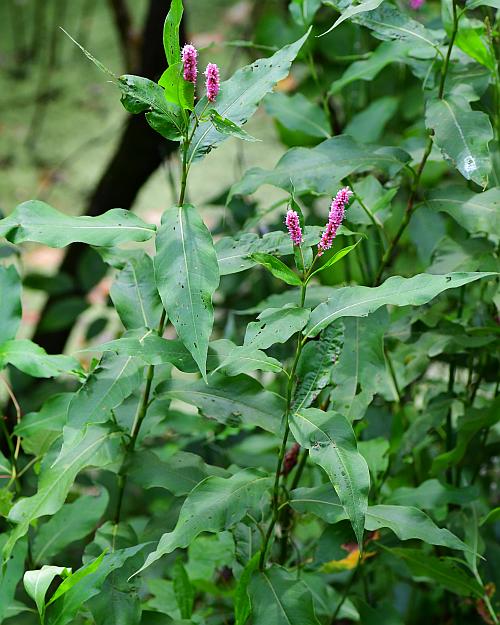Persicaria amphibia (L.) Delarbre
Water Smartweed

Native
CC = Amb
CW = -5
MOC = 63
© SRTurner
Persicaria amphibia (L.) DelarbreWater Smartweed | |
 |
Native CC = Amb CW = -5 MOC = 63 |
© SRTurner |
|
Family - Polygonaceae Habit - Perennial forb, usually with rhizomes and/ or stolons. Stem - Prostrate to ascending or erect, to 1.2 m in terrestrial plants, to 3.0 m in aquatic plants, glabrous or short-hairy, often rooting at the lower nodes. Ocreae persistent, usually tearing with age, 5-50 mm long, cylindric or flared toward the tip, tan to white and papery most of the length, green and herbaceous toward the tip, sometimes with a stipulelike flange of tissue at the otherwise oblique tip, the margin lacking bristles (entire or nearly so) or with erect bristles 0.5-4.5 mm long, the surface glabrous or short-hairy, not gland-dotted.
Leaves - Alternate, simple, mostly petiolate. Petioles absent or to 3 cm long. Leaf blades 2-15 cm long, 1-6 cm wide, broadly lanceolate to broadly ovate, angled or tapered to rounded, truncate, or cordate at the base, rounded or more commonly angled or tapered to a bluntly or sharply pointed tip, the surfaces glabrous or appressed-hairy, unarmed (but the margins roughened to the touch), lacking impressed glands, lacking a reddish or purplish area on the upper surface.
Inflorescences - Terminal, solitary or occasionally paired, 1-15 cm long, 8-20 mm wide, erect or ascending, dense, uninterrupted or interrupted toward the base, the stalk 1-5 cm long, glabrous or hairy, the hairs often gland-tipped. Ocreolae overlapping except sometimes toward the axis base, the margins with bristles 0.5-1.0 mm long, the surface usually glabrous, not gland-dotted.
Flowers - Flowers sometimes functionally pistillate or staminate, 1-3 per fascicle, those of some plants with the stamens exserted and those of others with the styles exserted. Perianth bright reddish pink to bright pink, bell-shaped, not gland-dotted, the tepals 5, 4-6 mm long, fused in the basal 1/3, the nerves noticeable, not anchor-shaped. Stamens 5, exserted or not, the anthers pink or red. Styles 2-branched above the midpoint, not or only slightly exserted, not persistent.
Fruits - Achenes 2-3 mm long, 1.8-2.6 mm wide, not exserted, bluntly 2-angled, beakless, the faces convex, the surface smooth or minutely granular, dark brown, shiny or dull. Flowering - June - October. Habitat - Swamps, sloughs, oxbows, marshes, ponds, lakes, bottomland prairies, streams, and botttomland forest margins, ditches, railroads, roadsides, wet disturbed areas. Frequently emergent aquatics, less commonly floating-leaved. Origin - Native to the U.S. Lookalikes - Broadly, P. pensylvanica, P. maculosa, P. bicornis, P. orientalis. Other info. - This common smartweed is found across most of Missouri, and throughout nearly all of the U.S. and Canada. Like most smartweeds, it makes its home in wet areas. Although the inflorescences strongly resemble those of several other species, the others tend to have a more branching habit. P. amphibia tends to be an erect plant with erect inflorescences (but see below), and with one or two inflorescences at the stem tip. The leaves are broad and usually deep green on the upper surface. The flowers are heterostylous, with some having exserted stamens and others having exserted styles. More discussion on this trait is available on the page for P. bicornis.
Photographs taken at Marais Temps Clair Conservation Area, St. Charles County, MO, 7-28-2020, and along the Katy Trail near Dutzow, Warren County, MO, 8-20-2021 (SRTurner); also at the Kansas City Zoo, 7-24-00, and in the Pictured Rocks National Seashore, MI., 7-21-03 (DETenaglia). |